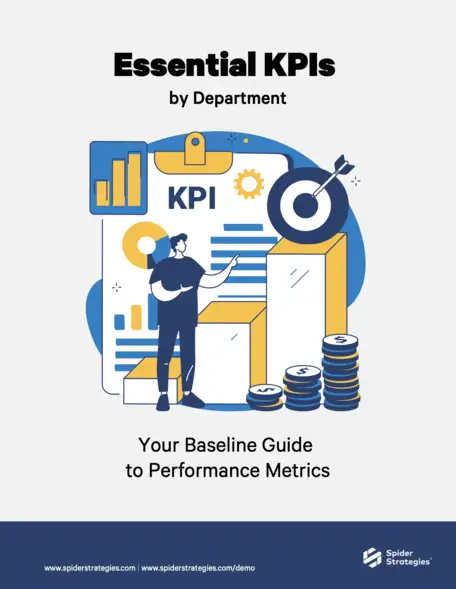KPIs vs. Metrics vs. Measures: The Similarities and Differences

For businesses today, having access to performance data is crucial but not enough on its own. Companies need to translate metrics into usable insights to set goals, prioritize initiatives, and optimize strategies. The key is properly leveraging measures, metrics, and key performance indicators (KPIs) together to build an effective tracking framework.
This comprehensive guide will dive into what sets measures, metrics and KPIs apart, how to align them, and the best ways of leveraging them to drive better business performance.
KPIs vs. Metrics vs. Measures: What’s the difference?
This article dives deep into the nuanced differences between key performance indicators, business metrics, and measures. Before we get into the weeds, however, here’s a quick overview of the differences between KPIs, metrics, and measures.
- Measures are simple objective numbers. They’re single data points, like current cash flow on a balance sheet.
- Metrics are measures examined over a period of time. They measure progress and often have goals or benchmarks.
- KPIs are your most important metrics. All KPIs are metrics, but not all metrics are KPIs.
As you can imagine, choosing the right KPIs is incredibly important because KPIs help focus your organization on what matters most. To help you measure your most important business objectives, we’ve put together examples of metrics by both industry and department. This list of KPIs can help you choose from the different metrics commonly used across industry, government, and nonprofit.
Measures Provide the Raw Data as Inputs
Measures are the tools, mechanisms and systems that generate the raw data needed for performance tracking. They provide the inputs while metrics and KPIs analyze the outputs.
Some examples of common business measures include:
- Web analytics for tracking website traffic, conversions, etc.
- CRM data and reports
- Sales team tracking and reports
- Customer satisfaction surveys
- Employee time sheets
- Accounting systems
Measures should provide consistent, quality data. For example, sending the same survey annually allows apple-to-apple trending. The right measures also generate data efficiently. Too much extraneous data can waste resources while insufficient data leaves blind spots.
The Power of Metrics for Measuring Performance
If measures represent raw inputs, then metrics are the outputs - quantifiable measures that provide context. The number of website visitors today is a measure; conversion rate is a metric.
Effective metrics are:
- Quantifiable - They can be measured numerically.
- Consistent - Metrics are calculated the same way over time.
- Relevant - They measure aspects of performance that matter.
- Benchmarked - Metrics can be compared industry-wide.
- Easy to understand - Metrics tell a clear story.
Well designed metrics like revenue growth, customer satisfaction (CSAT) and lead conversion rate are invaluable for monitoring business performance.
Converting Metrics to KPIs
While all key performance indicators (KPIs) are metrics, not all metrics qualify as KPIs. The difference lies in alignment with strategic business goals.
KPIs represent the vital few performance metrics most critical for an organization to monitor. They track progress on the highest priorities.
For example, brand awareness could be a standard marketing metric. But for a growing company focused on rapid expansion, brand awareness becomes a KPI. Alternatively, net promoter score (NPS) is a common customer service KPI since it tracks loyalty and satisfaction - almost always goals.
Characteristics of Effective KPIs
Here are the crucial criteria for designating a metric as a KPI:
- Strategic - The KPI ties directly to a strategic goal or objective.
- Quantifiable - The KPI has measurable data behind it.
- Relevant - The KPI impacts desired business outcomes.
- Time-bound - Data comes at regular intervals for tracking.
- Actionable - If it’s not something you can affect, it’s not a KPI.
- Achievable - Only set goals that can be reached
Setting KPI Target Levels
KPIs not only track performance over time, they should have target levels defined. This quantifies:
- How much improvement is expected
- When the target should be hit
- Who owns each target
For example, a sales team might have a target revenue growth KPI of 10% year-over-year by Q4 with the sales VP as owner. Targets provide something to strive towards. They also indicate when KPIs are off track.
Balance Between KPIs and Metrics
KPIs represent the vital few metrics, but other metrics provide context around factors impacting KPI performance. For example, a manufacturing plant might track production volume as a KPI. Metrics like machine downtime, defective rate, and utilization offer context on what could influence volumes.
The right balance presents a KPI dashboard along with metric diagnostics. Metrics also feed into high-level KPIs. Company revenue is informed by sales, customer, product and regional KPIs. In summary, KPIs track strategic goals while metrics add insights. Both are needed for a complete picture.
Aligning Measures, Metrics and KPIs
The connection between measures, metrics and KPIs creates an aligned performance tracking framework.
The Hierarchy
As mentioned above, measures, metrics, and key performance indicators build on each other. They all measure performance, but there are key differences between them.
- Measures generate raw data
- Metrics calculate quantifiable performance measures
- KPIs are the subset of strategic goal metrics
Creating an Aligned System
With this hierarchy in mind, an effective system involves:
- Define organizational goals and strategies. KPIs can't be designed without strategic alignment. What does success look like?
- Identify KPIs. Which few metrics truly reflect progress on goals? Limit to essential KPIs.
- Select supporting metrics. What other metrics provide insights around KPI performance?
- Establish measures. Assess if current measurement tools or new ones are needed for data.
- Set targets. Determine target levels and timeframes for KPIs based on goals.
- Monitor and analyze regularly. Track KPIs consistently against targets, not just sporadically. Examine metrics for diagnostics.
- Optimize strategies and measures. Use insights to fine-tune strategies, processes, and measures as needed.
This facilitates a linked system from raw data to strategic insights.
Best Practices for Tracking and Using KPIs
Approaching KPIs with clearly defined measures and metrics unlocks immense potential value. Here are some best practices for companies:
- Limit KPI quantity - Be selective. Aim for 1-5 per department aligned to specific goals. Too many become noise.
- Set KPI targets - Targets create something to strive for beyond just assessing trends.
- Visualize KPIs - Reports, dashboards and data visualizations should make KPIs easily trackable.
- Evaluate consistently - Establish standard monthly or quarterly KPI reviews instead of sporadic looks.
- Dig into metrics - Don’t just examine KPI scores at surface level. Dive into supplementary metrics for insights.
- Revisit and adjust - As strategies evolve, existing KPIs and metrics may no longer fit. Reassess them.
- Take action - Use KPI and metric insights to fuel change. Performance tracking without action is wasted effort.
Common Challenges and Solutions
Like any business process, establishing effective performance tracking through measures, metrics and KPIs comes with challenges. Here are some frequent issues and ways to address them:
- Too many metrics and KPIs - It’s easy to go overboard measuring everything possible. Maintain selectivity and limit KPIs to essentials.
- Data inconsistency - Sudden methodology changes can reduce trend visibility. Aim for consistency, and note methodology shifts.
- Poor data quality - Bad data provides bad insights. Spot check quality and accuracy.
- Lack of buy-in - KPIs fail without company-wide ownership. Engage teams early in the design process.
- No action taken - Don’t let insights go to waste. Review KPIs in planning to create action.
- Outdated metrics - As strategies evolve, existing KPIs may no longer fit. Revisit and adjust them.
Proactively mitigating these issues helps sustain maximum value from measuring performance.
Examples of KPIs and Metrics by Department
Let’s look at some examples of potential KPIs and supplementary metrics across different business functions:
Sales KPIs and Metrics
KPIs
- Overall sales revenue
- Revenue by product line
- Average deal size
- Customer lifetime value
Metrics
- Sales cycle length by rep
- Lead conversion rate
- Quota attainment by rep
- Customer retention rate
- Net profit margin
Marketing KPIs and Metrics
KPIs
- Cost per lead
- Conversion rate
- Customer acquisition cost
- Return on investment
Metrics
- Traffic sources
- Lead quality score
- Email open rate
- Number of new customers
- Social media likes
- Marketing team utilization
Customer Service KPIs and Metrics
KPIs
- Customer satisfaction (CSAT)
- Net promoter score (NPS)
- Churn rate
Metrics
- Case resolution time
- First contact resolution %
- Customer effort score
HR KPIs and Metrics
KPIs
- Turnover rate
- Time to hire
- Open positions
Metrics
- Applicants per opening
- Employee satisfaction
- Internal fill percentage
This illustrates how KPIs should be supplemented with metrics for insights.
Looking for More KPIs by Department?
Email the Guide and discover the metrics that matter most for every team.

Guiding Principles for Measurement Success
Hopefully this guide has illuminated some guiding principles for unlocking better performance through aligned measures, metrics and KPIs:
- Start with strategy - KPIs can’t be designed in a vacuum. Identify strategic goals first.
- Limit KPI quantity - Zero in on the 1-5 most essential KPIs per department or function. Avoid overload.
- Supplement with metrics - KPIs are the dashboard, but metrics offer diagnostic details.
- Focus on quality - Accurate, consistent and relevant data is crucial for metrics and KPIs.
- Set targets - KPIs should have target levels and timeframes defined.
- Monitor consistently - Establish routines for regularly reviewing KPIs instead of one-offs.
- Take action - Use KPI insights to fuel change - measurement for measurement's sake is wasted effort.
With these principles in mind, organizations can transform disconnected data into strategic performance insights.
Key Takeaways
Here are some key takeaways from this guide on measures, metrics and KPIs:
- Measures generate the raw data for analysis.
- Metrics calculate quantifiable performance measures.
- KPIs are the strategic subset of metrics most vital to goals.
- A hierarchy exists with measures enabling metrics, and metrics driving KPIs.
- Good KPIs are strategic, quantifiable, relevant, timely and actionable.
- KPIs track strategic goals while metrics provide context.
- Leading companies limit KPI quantity to the essential few.
- Consistent measurement and defined KPI targets enable trend visibility.
- Proper alignment unlocks better performance tracking and data-driven decisions.
For business leaders, the time is now to evaluate measures, metrics and KPIs. Are they aligned and providing actionable insights? If not, the framework needs improvement for better performance.
Frequently Asked Questions
What are the main differences between measures, metrics, and KPIs?
Measures generate the raw data for analysis. Metrics calculate quantifiable performance measures. KPIs designate the strategic subset of metrics vital to goals.
What makes an effective KPI?
Effective KPIs are strategic, quantifiable, relevant, timely, and actionable. They tie directly to organizational goals and objectives.
How many KPIs should an organization track?
Organizations should limit KPIs to the vital few - around 1-5 per department. Tracking too many diffuses focus.
Why use both KPIs and other metrics?
KPIs provide the high-level view while metrics offer details and context. Businesses need both for a complete picture.
How can companies ensure data quality and consistency for metrics?
Use consistent methodology, spot check for accuracy, monitor data integrity, and document any major changes.
Should KPIs have target levels defined?
Yes, target levels and timeframes help provide something to strive for beyond just assessing trends.
How often should KPIs be reviewed?
KPIs should be evaluated consistently, such as through monthly or quarterly reviews, not just sporadically.
How can KPIs actually drive better performance?
Insights should fuel change - adjust strategies, processes, resource allocation based on KPI data. Measurement without action is wasted effort.
What are some common pitfalls to avoid?
Some issues to avoid include too many metrics/KPIs, inconsistent data, lack of buy-in, outdated metrics, and failure to take action on insights.
How can measures, metrics and KPIs become aligned?
Clearly define strategic goals, identify aligned KPIs, establish supporting metrics, implement right measures, set KPI targets, monitor routinely, and optimize.
Demo then Free Trial
Schedule a personalized tour of Spider Impact, then start your free 30-day trial with your data.






